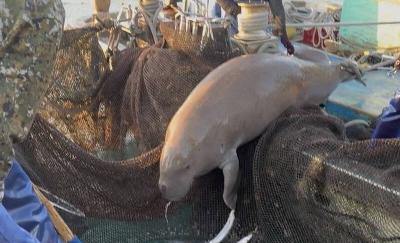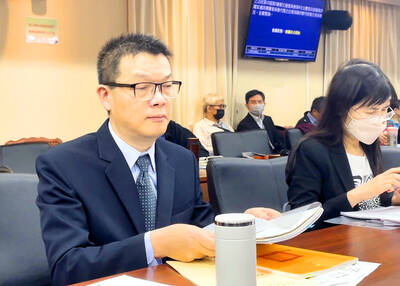An academic on Sunday urged businesses to get used to hiring older people as Taiwan is poised to become a “super aged society” next year.
Local enterprises must recognize the “inevitability” of the nation’s workforce getting older and adjust recruitment policies accordingly, said Hsin Ping-long (辛炳隆), an associate professor at National Taiwan University’s Graduate Institute of National Development.
Many local businesses do not know how to use older workers, especially enterprises led by “second-generation” leaders, Hsin said, referring to the common practice at local small to medium-sized businesses in which the business owner’s offspring typically takes over the leadership after the parent retires.

Photo: CNA
Younger bosses might not wish to recruit older people to work as subordinates, Hsin said.
This traditional cultural attitude of linking age with workplace seniority needs to be addressed as the nation’s workforce becomes older on average, he said.
An unwillingness to hire older workers is particularly pronounced in service industries, such as in hotel and catering, where employers are accustomed to recruiting younger people, even though they face staffing shortages, he said.
“It is not that [older workers] are unemployable, but rather because enterprises are not used to or not willing” to hire them, he said.
A National Development Council report released yesterday showed that Taiwan’s population structure is to transition next year from an “aged society” — where between 14 and 20 percent of the population are aged 65 or older — to a “super aged society,” meaning that 20 percent or more of the total population are aged 65 years or older.
Data from the Directorate-General of Budget, Accounting and Statistics showed that the so-called “silver-haired workforce” of people aged 65 and over reached 200,000 in 2012, 320,000 in 2020 and 400,000 last year.
The proportion of Taiwan’s workforce aged 65 and older increased by 5.52 percentage points in the first eight months of the year, whereas most age group categories under 44 years old posted declines, the data showed.
This indicates that workers aged 44 and over — particularly “silver-haired” workers — accounted for a large part of the overall workforce, showing that the Ministry of Labor’s efforts to encourage older workers to remain in employment has been successful to some extent.
One of the main causes of Taiwan’s aging workforce is the low birthrate.
Routine data published by the Ministry of the Interior last week showed that Taiwan’s birthrate of 6.15 per 1,000 people was lower than the death rate of 8.11 per 1,000.
The nation’s population has declined every month this year, the data showed.
The long-term goal in addressing Taiwan’s super-aged society should be to raise the birthrate, Hsin said, adding that the government should encourage businesses to employ older workers and reduce their labor needs, potentially by adopting automation or even artificial intelligence applications in the shorter term.

‘DENIAL DEFENSE’: The US would increase its military presence with uncrewed ships, and submarines, while boosting defense in the Indo-Pacific, a Pete Hegseth memo said The US is reorienting its military strategy to focus primarily on deterring a potential Chinese invasion of Taiwan, a memo signed by US Secretary of Defense Pete Hegseth showed. The memo also called on Taiwan to increase its defense spending. The document, known as the “Interim National Defense Strategic Guidance,” was distributed this month and detailed the national defense plans of US President Donald Trump’s administration, an article in the Washington Post said on Saturday. It outlines how the US can prepare for a potential war with China and defend itself from threats in the “near abroad,” including Greenland and the Panama

A wild live dugong was found in Taiwan for the first time in 88 years, after it was accidentally caught by a fisher’s net on Tuesday in Yilan County’s Fenniaolin (粉鳥林). This is the first sighting of the species in Taiwan since 1937, having already been considered “extinct” in the country and considered as “vulnerable” by the International Union for Conservation of Nature. A fisher surnamed Chen (陳) went to Fenniaolin to collect the fish in his netting, but instead caught a 3m long, 500kg dugong. The fisher released the animal back into the wild, not realizing it was an endangered species at

The High Prosecutors’ Office yesterday withdrew an appeal against the acquittal of a former bank manager 22 years after his death, marking Taiwan’s first instance of prosecutors rendering posthumous justice to a wrongfully convicted defendant. Chu Ching-en (諸慶恩) — formerly a manager at the Taipei branch of BNP Paribas — was in 1999 accused by Weng Mao-chung (翁茂鍾), then-president of Chia Her Industrial Co, of forging a request for a fixed deposit of US$10 million by I-Hwa Industrial Co, a subsidiary of Chia Her, which was used as collateral. Chu was ruled not guilty in the first trial, but was found guilty

DEADLOCK: As the commission is unable to forum a quorum to review license renewal applications, the channel operators are not at fault and can air past their license date The National Communications Commission (NCC) yesterday said that the Public Television Service (PTS) and 36 other television and radio broadcasters could continue airing, despite the commission’s inability to meet a quorum to review their license renewal applications. The licenses of PTS and the other channels are set to expire between this month and June. The National Communications Commission Organization Act (國家通訊傳播委員會組織法) stipulates that the commission must meet the mandated quorum of four to hold a valid meeting. The seven-member commission currently has only three commissioners. “We have informed the channel operators of the progress we have made in reviewing their license renewal applications, and